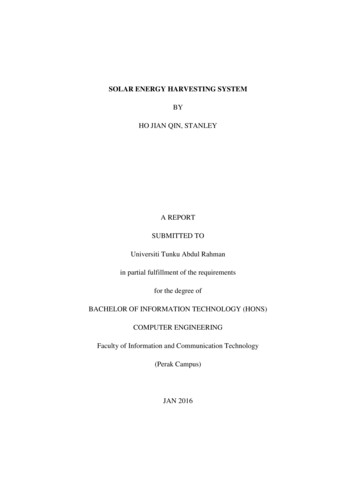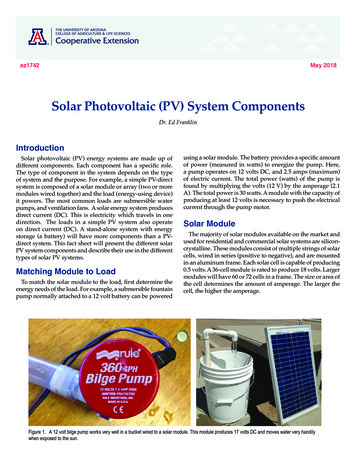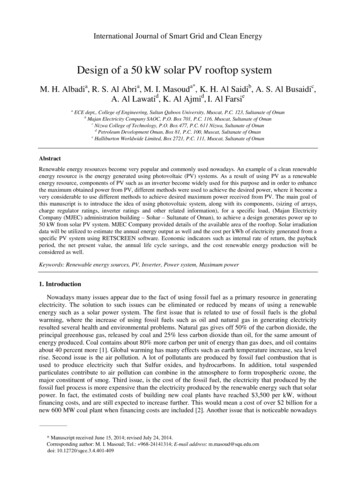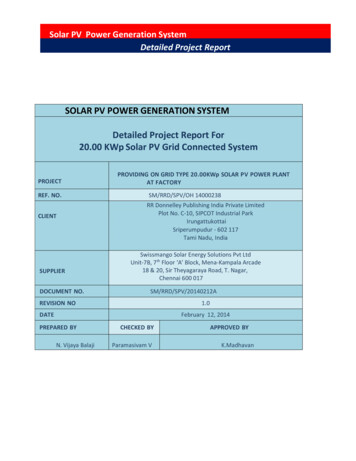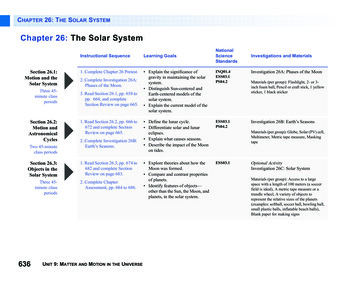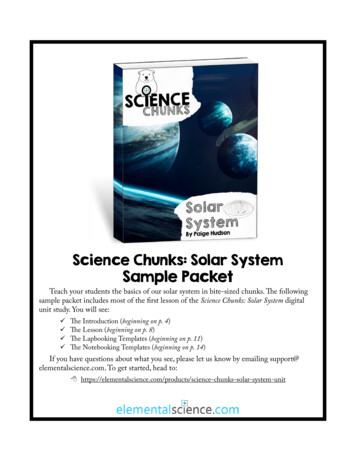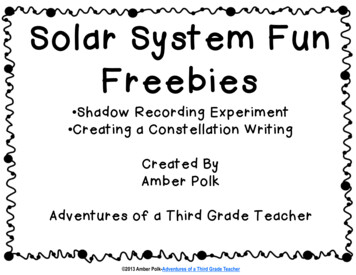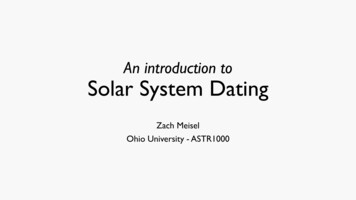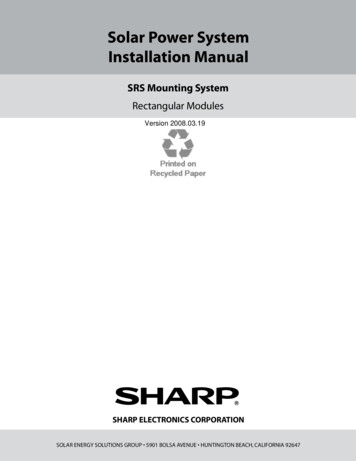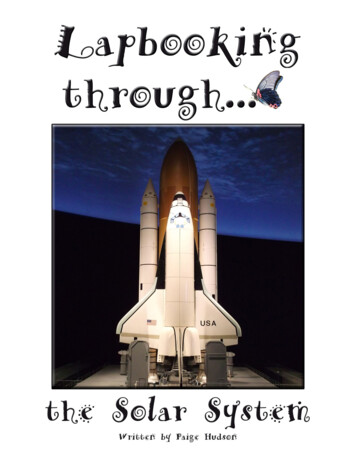
Transcription
Lapbooking through the Solar SystemLapbooking through the Solar SystemSecond Edition 2018Copyright @ Elemental Science, Inc.Email: support@elementalscience.comDigital EditionAll contents copyright 2013, 2018 by Elemental Science. All rights reserved.Copyright PolicyNo part of this document or the related files may be reproduced or transmitted in any form, by any means(electronic, photocopying, recording, or otherwise) without the prior written permission of the author. Theauthor does give permission to the original purchaser to photocopy all templates and other supplemental materialin this guide for use within their immediate family only.Limit of Liability and Disclaimer of Warranty: The publisher has used its best efforts in preparing this book, andthe information provided herein is provided “as is.” Elemental Science makes no representation or warrantieswith respect to the accuracy or completeness of the contents of this book and specifically disclaims any impliedwarranties of merchantability or fitness for any particular purpose and shall in no event be liable for any loss ofprofit or any other commercial damage, including but not limited to special, incidental, consequential, or otherdamages.Trademarks: This book identifies product names and services known to be trademarks, registered trademarks,or service marks of their respective holders. They are used throughout this book in an editorial fashion only. Inaddition, terms suspected of being trademarks, registered trademarks, or service marks have been appropriatelycapitalized, although Elemental Science cannot attest to the accuracy of this information. Use of a term in thisbook should not be regarded as affecting the validity of any trademark, registered trademark, or service mark.Elemental Science is not associated with any product or vendor mentioned in this book.2
3Lapbooking through the Solar SystemLapbooking through Solar SystemTable of ContentsIntroduction.5Lapbook Overview8Books and Materials List9Lessons.11Lesson 1: Our Solar System12Lesson 2: The Sun14Lesson 3: Mercury16Lesson 4: Venus18Lesson 5: The Earth & Moon20Lesson 6: Mars22Lesson 7: Jupiter24Lesson 8: Saturn26Lesson 9: Uranus28Lesson 10: Neptune30Lesson 11: Dwarf Planets32Lesson 12: Asteroids, Comets, and Meteors34Appendix.37Blank Narration Sheet38Blank Activity Sheet39Blank Vocabulary Cards for Older Students40Planet Templates for Projects43Paper-mâché Planet Directions45Phases of the Moon46Templates.T-1Solar System Lapbook Cover Page TemplateT-2Solar System SheetT-3The Sun Mini-bookT-4Mercury Tab-bookT-5
4Lapbooking through the Solar SystemThe Planets PoemT-6Venus Tab-bookT-7Earth Tab-bookT-8Moon Mini-bookT-9Mars Tab-bookT-10Inner and Outer Planets LabelsT-11Jupiter Tab-bookT-12Saturn Tab-bookT-13Uranus Tab-bookT-14Neptune Tab-bookT-15Pluto Tab-bookT-16Asteroid Mini-bookT-17Comet Mini-bookT-18Vocabulary CardsT-19 to T-24
Lapbooking through the Solar System5IntroductionLapbooking through the Solar System is a unique and versatile program that leads you through asurvey of the planets in our solar system using a lapbook to document the journey. It is designed tobe a gentle approach to homeschool science education based on the Unit Study method suggested inSuccess in Science: A Manual for Excellence in Science Education by Bradley and Paige Hudson. Thisstudy can be used as a stand-alone science program for K-2nd grade or in conjunction with anotherearth science program for an older student.What is a lapbook?Lapbooks are educational scrapbooks that fit into the lap of the student. Typically they are acollection of related mini-books on a certain subject that have been glued into a file folder for easyviewing, but they can also include pictures or projects that the students have completed. In thesame way that notebooking does not require regurgitation of facts; lapbooking causes the students tointeract with the materials instead of just responding to comprehension questions.Lapbooks are extremely versatile because they can be used in conjunction with any subjectthe students are learning about. They are excellent tools to use with elementary students as a way ofreinforcing what they are learning because this age group tends to prefer a more creative format ofnotebooking.The heartbeat of the lapbook is the mini-books that are placed inside. Each of these bookletscontains information on topics related to the main subject of the lapbook. They can be in a varietyof shapes and sizes, but the cover should have a picture related to the subject as well as a title. Theinterior of each booklet should contain several sentences detailing what the students have learnedabout the topic in their own words. The mini-books will each pertain to different sub-topics of themain topic. In other words, for this lapbook your main topic is our solar system and your relatedmini-books are on Mars, Venus, Jupiter, and more.Lapbooks serve as beautiful scrapbooks that the students can continue to learn from for yearsto come, which makes them a beneficial addition to the students’ science education.What is included in this program?Lapbooking through the Solar System includes all of the basic components of elementary scienceeducation as explained in our book.1. Science-Oriented Books – The elementary student is an empty bucket waiting to be filledwith information and science-oriented books are a wonderful way to do that. These books caninclude appropriate children’s science encyclopedias, living books for science, and/or children’snon-fiction science books. In this program, the reading assignments and additional booksscheduled in the lesson fulfill this component. The reading assignments are broken for youinto two levels, younger students (K-2nd grade) and older students (3rd-5th grade).2. Notebooking – The purpose of the notebooking component for elementary scienceeducation is to verify that the students have placed at least one piece of information intotheir knowledge bucket. You can use notebooking sheets, lapbooks, and/or vocabulary wordsto fulfill this requirement. This unit includes all the templates and pictures you will need to
Lapbooking through the Solar Systemcomplete a lapbook on plants as well as vocabulary words to coordinate with each lesson.3. Scientific Demonstrations or Observations – Scientific demonstrations and observationsare meant to spark the students’ enthusiasm for learning science, to work on their observationskills, and to demonstration the principles of science for them. This component of elementaryscience education can contain scientific demonstrations, hands-on projects, and/or naturestudies. The coordinating activities found in this guide fulfill this section of elementaryscience instruction.If you would like to read more about the concepts introduced in the above points, check out Successin Science: A Manual for Excellence in Science Education and the following articles from ElementalBlogging. What Are Living Books? – This article clearly shares the difference between living books andencyclopedias, especially in the context of science. / The Basics of Notebooking – This article details the basic components of notebooking alongwith how a few suggestions on what notebooking can look like. king/ Scientific Demonstrations vs. Experiments – This article explains the difference betweenscientific demonstrations and experiments along with when and how to employ thesemethods. ific-demonstrations-vs-experiments/How can I use this program?Each lesson in this program was designed to be completed over several days or up to one week.The lesson contains reading assignments from the selected books. You can choose to break theseselections up over the several days or do them all at once. If you are using this program with youngerstudents, read the selected pages to them. If you are using this program with older students, you canchoose to have them read the assigned pages on their own or you can read the selected pages to them.After you complete the reading assignment, have the students tell you what they have learnedfrom the selection. This can simply be what they found to be the most interesting or somethingnew that they have learned from the reading. You can choose to write the sentences for them orhave them copy them into the mini-book. If you are using this program with older students, Irecommend that you have them do all their own writing. Once the students have finished writing,have them color the related picture on the mini-book. Once the mini-book is complete, glue it intotheir lapbook using the overview sheet on pg. 7 as a guide.At another time during the week, review the vocabulary with the students. You can have themmemorize each of the definitions or just go over each of the words with the lesson before adding thecard to the vocabulary pocket. I have also included a set of blank vocabulary cards to use with anolder student in the Appendix on pp. . If you use the blank vocabulary cards, have the studentslook up the vocabulary words in the science encyclopedia of your choice or dictate the provideddefinition to them. Then, have them write the definition on the back of each card. I recommend thatyou print the blank vocabulary cards out on card stock for durability.6
Lapbooking through the Solar SystemFinally, you can finish the week by reading to the students one of the related books from theadditional book list. After you finishing reading, do an additional activity with the students. If youwould like to record what they have learned, there are two template pages provided for you to use inthe appendix of this book on pp. .I have also included a possible schedule for each lesson to give you an idea of how to plan outeach one. These schedules spread the assigned work for out over four days. If you choose to completethe program in this manner, this lapbook will take you six weeks to complete.Final ThoughtsAs the author and publisher of this curriculum, I encourage you to contact me with anyquestions or problems that you might have concerning Lapbooking through the Solar System atsupport@elementalscience.com. I will be more than happy to answer them as soon as I am able. Ihope that you will enjoy creating memories using Lapbooking through the Solar System!7
Lapbooking through the Solar SystemLapbook OverviewYou will need 4 sheets of card-stock or one file folder. Begin by taping the two sheets togetheron the longest edge, to look like this:InsideOutside(shaded area is where the tape or fold is)Overall DirectionsFor each mini-book have the students color the pictures. Then, write the narration sentencesfor the students or have them copy the information into the inside of the mini-book. Finally, gluethe mini-books and poems onto the lapbook. You can use the cover template provided or allow thestudents to decorate the cover as they choose.8
Lapbooking through the Solar SystemBooks and Materials ListBooks ScheduledThe following books are what I used while planning the reading assignments for thiscurriculum:Younger StudentsDK First Space EncyclopediaOlder StudentsDK Eyewitness AstronomyHowever you could certainly use the encyclopedias you already have on hand or books from thelibrary. Simply look up the topic assigned for the day, read about it and complete the section in yourlapbook.Additional Materials NeededThe following materials will be needed to complete the lapbook: 4 sheets of 8 ½ by 11 cardstock OR 2 file folder Colored pencils or crayons Markers for decorating the cover Glue stick Scissors StaplerAdditional materials will vary according to the activities you choose to do.Overview of Study Lesson 1: Our Solar SystemLesson 2: The SunLesson 3: MercuryLesson 4: VenusLesson 5: The Earth and the MoonLesson 6: MarsLesson 7: JupiterLesson 8: SaturnLesson 9: UranusLesson 10: NeptuneLesson 11: Dwarf PlanetsLesson 12: Asteroids, Comets, and Meteors9
Lapbookingthrough theSolar SystemLessons
Lapbooking through the Solar System Lesson Pages12Lesson 1: Our Solar SystemScience-Oriented BooksReading AssignmentsYounger Students“The Milky Way” DK First Space Encyclopedia pp. 18-19“The Solar System” DK First Space Encyclopedia pp. 50-51Older Students“The Solar System” DK Eyewitness Astronomy pp. 36-37“Our Galaxy and Beyond” DK Eyewitness Astronomy pp. 62-63Additional Books from the LibraryThe Milky Way (Exploring Space) by Martha E. H. Rustad and Ilia I. RoussevThe Milky Way (Galaxy) by Gregory L. VogtThere’s No Place Like Space: All About Our Solar System (Cat in the Hat’s Learning Library)by Tish Rabe and Aristides Ruiz13 Planets: The Latest View of the Solar System (National Geographic Kids) by David A.AguilarScholastic Reader Level 2: Solar System by Gregory VogtThe Planets in Our Solar System (Let’s-Read-and-Find. Science, Stage 2) by Franklyn M.Branley and Kevin O’MalleyNotebookingVocabularyHave the students cut out and glue the vocabulary pocket on pg. T-11 into their lapbook. Then,have them cut out and add the following card to their vocabulary pocket. Solar system – A group of planets and other objects all in orbit around the Sun. (Completedcard on pg. T-11, Blank card on pg. 40)Mini-book Assembly Instructions1. Solar System Fact Sheet – Have the students cut out the template. Have them color thepictures and label each of the planets in our solar system (see below). Have the students also fillin “Milky Way” for the name of our galaxy. Then, glue
Lapbooking through the Solar System 8 Lapbook Overview You will need 4 sheets of card-stock or one file folder. Begin by taping the two sheets together on the longest edge, to look like this: Inside Outside (shaded area is where the tape or fold is) Overall Directions For each mini-book have the students color the pictures. Then, write the narration sentences for the students or have them copy .

